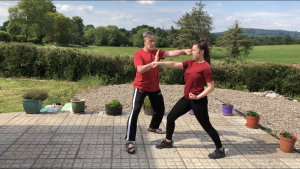How To Do One Step Sparring at Home
 All this drill requires is two people, in which one could be a brother or sister or even one of your parents. It also requires very limited space. It doesn’t matter what grade you are, even a white belt can benefit from this. All what’s going to happen, especially for the main part, is your partner hold out their arm and you practice going around it. This is known as evading, and it should also be some fun once you both co-operate with each other. Now what follows is a full explanation of what one step sparring is all about.
All this drill requires is two people, in which one could be a brother or sister or even one of your parents. It also requires very limited space. It doesn’t matter what grade you are, even a white belt can benefit from this. All what’s going to happen, especially for the main part, is your partner hold out their arm and you practice going around it. This is known as evading, and it should also be some fun once you both co-operate with each other. Now what follows is a full explanation of what one step sparring is all about.
The concept of one step sparring is great to develop timing, evasion, blocking and striking. Some instructors stick to just one attack and others allow more. The philosophy, if one exists for one step sparring is the famous line: “One blow is sufficient for victory” is why most favour just one single strike. This is also one of the reasons we have the belt go around our waist once only.
Once both players have got their correct distance, they face each other in parallel ready stance. Then on an agreed signal of a loud Ki Hap or shout, one step sparring is practiced with your partner stepping towards you in a walking stance, middle punch, in which you have to apply a counter.
If you can manage to strike your partner on their blindside, rather than on their inside, as it helps translate to protecting your self better, therefore training your response in this way. Another famous line that is used in relation to sparring is the students ability to “Get off the line of attack”. This would be mostly in relation to a side kick that is well chambered and thrust sharply in your direction, while performed in a sliding motion. Equally getting off the line of attack of a punch would therefore require the attacker to aim the punch directly at your middle section.
One of the most common mistakes with all pre-arranged sparring, either three, two or what I am referring to here , one step sparring is punching slightly to your partners side , so he can b lock it easier, and you do not end up bruising your forearm.
This article is written mainly for my students during the lockdown period of Covid 19, 2020. So as most students are doing home practice and if they do not have a sibling as a partner, then either of your parents or an older sibling can be easily taught to step forward into a walking stance and punch.
A good way in which you can first practice this technique, is not having a partner consistently punching, so you can have a chance to judge distance, timing and the accuracy of using the correct tool, which is the knife hand for the block and the palm heel for the strike. Once you have mastered this to your satisfaction, then have your partner start in the parallel ready stance and step forward towards you and punch.
- Have your partner stand in a walking stance with the arm outstretched in a punch position, and have them hold this position, so you can practise this little chunk first.
- Next once this is mastered, have your partner go back to ready and YOU dictate when they attack, towards you in walking stance. Do this slowly first then have them increase their speed incrementally, again so you master, your getting out of their way,(evasion) and blocking and striking, but all this tactics need to be done simultaneously, that is the real deal with one step sparring.
- If you wish have your partner only punch on the right side with all these three parts and then move to the other side.
- Your partner will next attack with a pre-arranged signal, where they use a loud Ki Hap ( a loud shout) then your acknowledge by responding with a Ki Hap and the drill starts.
- If you really want to test your skills of reaction-time in relation to one step sparring, have your partner attack whenever they choose. This can be performed in the walking stance or you can change into any stance and any technique. Also you could perform the drill in a free style mode, where you step forward in an natural stance.
They are many techniques that your partner can use in which to attack with, rather than just a punch. Knife hand strike in an L stance, would be another key technique to practise, and another would be the back fist. Kicks can also be used, but the goal is mainly to improve your reaction, by evasion, blocking and striking. On number five above, this can get really hard on your forearms and some would say your inner personal fortitude, resilience and perseverance, especially if the partner and yourself have an agreement that you both really “go for it” by punching directly centre and not out to the side.
Finally just a word on stances. When I started Taekwon-Do we were made hold a walking stance for a long time while doing all the basic moves. It was boring, but because there were hardly no other martial arts available, or distractions like today, we stuck it out. Basic, boring, tiring and long. In Boxing there are four main punches. Four that’s it ! Jab, cross, hook and uppercut. Yes there are derivatives, like a shovel hook and a few more but basically four, with the jab and cross used mostly anyway.
The only other martial art around when I started in 1974, was Karate and I distinctly remember mocking these lads because they appeared to have low stances, and had very low number of techniques compared to Taekwon-Do. But they worked harder on a fewer techniques.
In a real fight, by the time you would have read the last paragraph, the fight would be over. It’s between three and ten seconds, so stability and the ability to hit first and hard from as stable position as possible, is something that all students need to take time to master. Them low stance can really develop strong legs, so the Karate, in which Taekwon-Do derived anyway, can teach us a lot.
If you want to have the confidence deep down to know that you can defend yourself in a real fight, invest the time to repeatedly drill one good strong technique. It is boring, not in the least bit artful or aesthetic, and can possibly lead to injury if practised over a long period, but it could save your life.
One step , when practiced properly with the right attitude, is fantastic to develop , timing, evasion, blocking, and striking . One step as taught in class, is done for a group of people, not an individual. Therefore you need to figure out which is you best technique, that works best for you and if you really had to use it would it work under realistic conditions. Stay safe .




